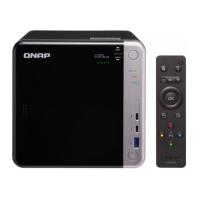
Do you have a question about the QNAP TS-453BT3 and is the answer not in the manual?
| Stepping | B1 |
|---|---|
| Tjunction | 105 °C |
| Processor code | SR2Z9 |
| Processor cache | 2 MB |
| Processor cores | 4 |
| Processor model | J3455 |
| System bus rate | - GT/s |
| Processor family | Intel® Celeron® |
| Processor socket | BGA 1296 |
| Processor codename | Apollo Lake |
| Processor frequency | 1.5 GHz |
| Processor cache type | Smart Cache |
| Processor lithography | 14 nm |
| Processor manufacturer | Intel |
| Processor package size | 24 x 31 mm |
| CPU configuration (max) | 1 |
| Conflict-Free processor | Yes |
| PCI Express slots version | 2.0 |
| Processor boost frequency | 2.3 GHz |
| Processor operating modes | 64-bit |
| ECC supported by processor | No |
| PCI Express configurations | 1x2+2x1, 4x1 |
| Thermal Design Power (TDP) | 10 W |
| On-board graphics card model | Intel® HD Graphics 500 |
| Maximum internal memory supported by processor | 8 GB |
| Memory slots | 2 x SO-DIMM |
| Internal memory type | DDR3L |
| RAID levels | 0, 1, 5, 6, 10 |
| Storage drive size | - \ |
| Storage drive capacity | 0 GB |
| Supported file systems | FAT32, HFS+, NTFS, ext3, ext4 |
| Storage drive interface | - |
| Number of M.2 (M & B) slots | 2 |
| Storage drive sizes supported | 2.5, 3.5 \ |
| Supported storage drive types | HDD & SSD |
| Total installed storage capacity | 0 TB |
| Number of storage drives installed | 0 |
| Supported storage drive interfaces | Serial ATA, Serial ATA II, Serial ATA III |
| Ethernet LAN data rates | 1000, 10000 Mbit/s |
| Ethernet LAN data rate supported (max) | 10000 Mbit/s |
| HDMI version | 1.4b |
| USB 2.0 ports quantity | USB 2.0 ports have a data transmission speed of 480 Mbps, and are backwards compatible with USB 1.1 ports. You can connect all kinds of peripheral devices to them. |
| Ethernet LAN (RJ-45) ports | 3 |
| USB 3.2 Gen 1 (3.1 Gen 1) Type-A ports quantity | 5 |
| Cables included | AC, LAN (RJ-45) |
| Number of screws | 28 |
| Chassis type | Tower |
| Cooling type | Active |
| Display type | OLED |
| Fan diameter | 120 mm |
| Product color | Black |
| LED indicators | HDD, LAN, Status, USB |
| Number of fans | 1 fan(s) |
| Cable lock slot type | Kensington |
| Storage temperature (T-T) | -20 - 70 °C |
| Operating temperature (T-T) | 0 - 40 °C |
| Operating relative humidity (H-H) | 5 - 95 % |
| AC input voltage | 100 - 240 V |
| AC input frequency | 50 - 60 Hz |
| Power supply location | External |
| Power consumption (typical) | 38.101 W |
| Power supply unit (PSU) capacity | 120 W |
| Type | NAS |
| Device class | Home & Home Office |
| Share folder | CIFS/SMB, FTP, WebDAV |
| Backup features | Cloud, iSCSI LUN |
| Browser supported | Apple Safari 7, Google Chrome, Microsoft Internet Explorer 10, Mozilla Firefox |
| Security algorithms | 256-bit AES, FIPS 140-2, HTTPS, SSH, SSL/TLS |
| Operating system version | 5.0.0 |
| Operating system installed | QNAP Turbo System |
| Mac operating systems supported | Mac OS X 10.10 Yosemite, Mac OS X 10.11 El Capitan, Mac OS X 10.12 Sierra, Mac OS X 10.7 Lion, Mac OS X 10.8 Mountain Lion, Mac OS X 10.9 Mavericks |
| Server operating systems supported | Windows Server 2003, Windows Server 2008 R2, Windows Server 2012, Windows Server 2012 R2 |
| Windows operating systems supported | Windows 10, Windows 7, Windows 8 |
| Number of execution units | 12 |
| Maximum number of PCI Express lanes | 6 |
| Memory types supported by processor | DDR3L, LPDDR3-SDRAM, LPDDR4-SDRAM |
| Memory channels supported by processor | Dual |
| Intel Identity Protection Technology version | 1.00 |
| Intel Small Business Advantage (SBA) version | 0.00 |
| On-board graphics card base frequency | 250 MHz |
| On-board graphics card burst frequency | 750 MHz |
| Processor ARK ID | 95594 |
| Harmonized System (HS) code | 84714100 |
| Depth | 226 mm |
|---|---|
| Width | 170 mm |
| Height | 168 mm |
| Weight | 2510 g |
| Package weight | 4050 g |
Lists the technical specifications of the TS-453BT3, including CPU, memory, storage, network, and ports.
Details the process for installing 3.5-inch, 2.5-inch drives, and M.2 SSDs into the NAS.
Step-by-step guide on how to increase the NAS memory capacity by upgrading or replacing memory modules.
Explains how to install the QTS operating system using Qfinder Pro, Cloud Key, or an HDMI connection.
Covers using the power button for normal and forced shutdown, and performing basic and advanced system resets.
Explains OLED error messages, LED status indicators, and beep alarm meanings for system monitoring.
Details the procedure for replacing a failed drive in a RAID array without shutting down the NAS.
Explains RAID recovery technology for unintentional drive disconnections or removals, and supported RAID types.